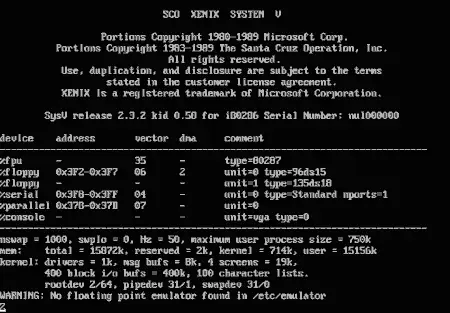Last Updated on: 26th July 2023, 12:51 pm
Web site: (not active)
Origin: USA
Category: Server
Desktop environment: CLI
Architecture: x86, PC/XT, PDP-11, Z8001, 68k
Based on: UNIX
Wikipedia: Xenix
Media: Install
The last version | Released: 3.2.4.2 | 1992
Xenix/SCO UNIX System V – a source closed, UNIX family operating system published in 1980 by Microsoft, then later sold to Santa Cruz Operation (SCO).
Microsoft(R) XENIX(R) System V/386 was the first release of Microsoft’s implementation of the UNIX(R) System V Operating System for the Intel(R) 80386 microprocessor.
XENIX is a multi-user solution that allows multiple users to be attached via inexpensive terminals to a single machine, thereby allowing the users to share the resources of the machine. It is also compatible with the UNIX System V Operating System – an operating system that is highly portable, and is to be found on a wide variety of architectures: large mainframes, minicomputers, technical and scientific workstations, and personal computers.
Starting in 1981, Microsoft has marketed its adaptation of the UNIX Operating System under the name XENIX. Microsoft’s goal was to provide high quality implementations of UNIX for computer systems based upon microprocessors. In doing so, Microsoft has become one of the major licensees of the UNIX Operating System, accounting for the majority of implementations sold upon microprocessor-based systems. In particular, a large application base has been built around Microsoft XENIX System V/286 for systems based upon the Intel 80286 microprocessor. Microsoft XENIX System V/386 for the Intel 80386 will preserve this application base, while opening up the full potential of the 80386 to developers and users.
Supported platforms were: PC/XT, x86, PDP-11, Z8001, 68k.





N1 image is missing. The m1 is not mislabeled either.